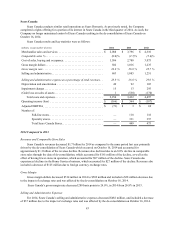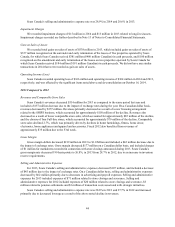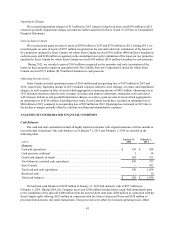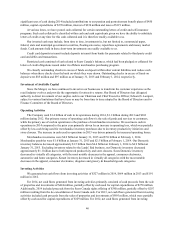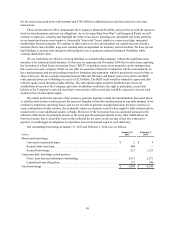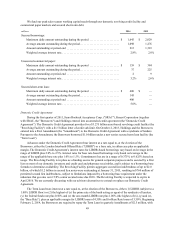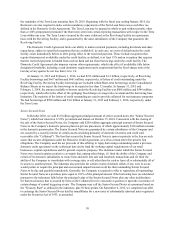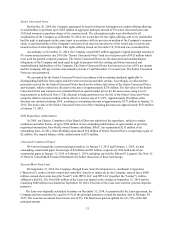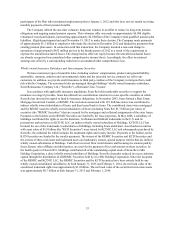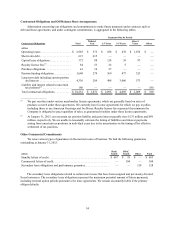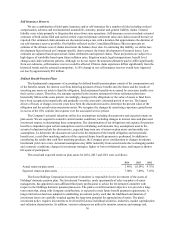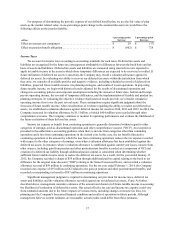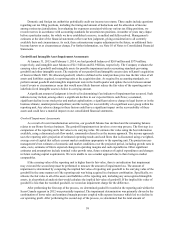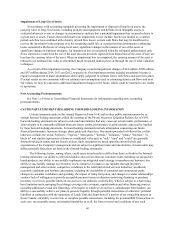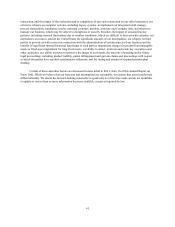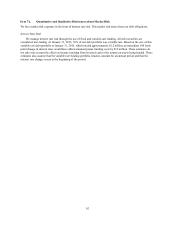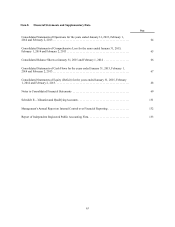Sears 2014 Annual Report Download - page 53
Download and view the complete annual report
Please find page 53 of the 2014 Sears annual report below. You can navigate through the pages in the report by either clicking on the pages listed below, or by using the keyword search tool below to find specific information within the annual report.53
participants of the Plan who terminated employment prior to January 1, 2012 and who have not yet started receiving
monthly payments of their pension benefits.
The Company offered the one-time voluntary lump sum window in an effort to reduce its long-term pension
obligations and ongoing annual pension expense. This voluntary offer was made to approximately 86,000 eligible
terminated vested participants, representing approximately $2.0 billion of the Company's total qualified pension plan
liabilities. Eligible participants had until November 19, 2012 to make their election. The Company made payments
of approximately $1.5 billion to employees who made the election in December 2012 and funded the payments from
existing pension plan assets. In connection with this transaction, the Company incurred a non-cash charge to
operations of approximately $452 million pre-tax in the fourth quarter of 2012 as a result of the requirement to
expense the unrealized actuarial losses. The charge had no effect on equity because the unrealized actuarial losses
are already recognized in accumulated other comprehensive income/(loss). Accordingly, the effect on retained
earnings was offset by a corresponding reduction in accumulated other comprehensive loss.
Wholly owned Insurance Subsidiary and Intercompany Securities
We have numerous types of insurable risks, including workers’ compensation, product and general liability,
automobile, warranty, asbestos and environmental claims and the extended service contracts we sell to our
customers. In addition, we provide credit insurance to third party creditors of the Company to mitigate their credit
risk with the Company. The associated risks are managed through Holdings’ wholly owned insurance subsidiary,
Sears Reinsurance Company Ltd. ("Sears Re"), a Bermuda Class 3 insurer.
In accordance with applicable insurance regulations, Sears Re holds marketable securities to support the
insurance coverage it provides. Sears has utilized two securitization structures to issue specific securities in which
Sears Re has invested its capital to fund its insurance obligations. In November 2003, Sears formed a Real Estate
Mortgage Investment Conduit, or REMIC. The real estate associated with 125 Full-line stores was contributed to
indirect wholly owned subsidiaries of Sears, and then leased back to Sears. The contributed stores were mortgaged
and the REMIC issued to wholly owned subsidiaries of Sears (including Sears Re) $1.3 billion (par value) of
securities (the "REMIC Securities") that are secured by the mortgages and collateral assignments of the store leases.
Payments to the holders on the REMIC Securities are funded by the lease payments. In May 2006, a subsidiary of
Holdings contributed the rights to use the Kenmore, Craftsman and DieHard trademarks in the U.S. and its
possessions and territories to KCD IP, LLC, an indirect wholly owned subsidiary of Holdings. KCD IP, LLC has
licensed the use of the trademarks to subsidiaries of Holdings, including Sears and Kmart. Asset-backed securities
with a par value of $1.8 billion (the "KCD Securities") were issued by KCD IP, LLC and subsequently purchased by
Sears Re, the collateral for which includes the trademark rights and royalty income. Payments to the holders on the
KCD Securities are funded by the royalty payments. The issuers of the REMIC Securities and KCD Securities and
the owners of these real estate and trademark assets are bankruptcy remote, special purpose entities that are indirect
wholly owned subsidiaries of Holdings. Cash flows received from rental streams and licensing fee streams paid by
Sears, Kmart, other affiliates and third parties, are used for the payment of fees and interest on these securities. In
the fourth quarter of fiscal 2013, Holdings contributed all of the outstanding capital stock of Sears Re to SRe
Holding Corporation, a direct wholly owned subsidiary of Holdings. Sears Re thereafter reduced its excess statutory
capital through the distribution of all REMIC Securities held by it to SRe Holding Corporation. Since the inception
of the REMIC and KCD IP, LLC, the REMIC Securities and the KCD Securities have been entirely held by our
wholly owned consolidated subsidiaries. At both January 31, 2015 and February 1, 2014, the net book value of the
securitized trademark rights was approximately $1.0 billion. The net book value of the securitized real estate assets
was approximately $0.7 billion at both January 31, 2015 and February 1, 2014.


